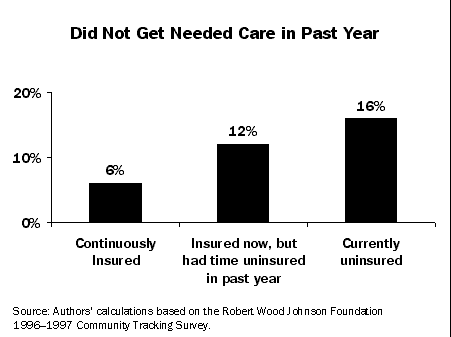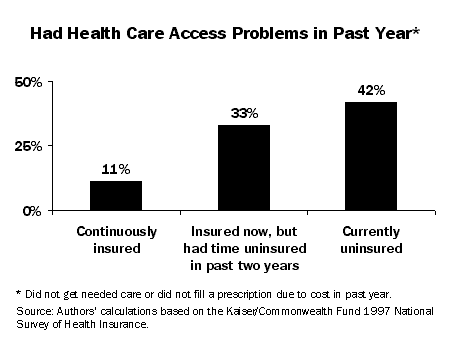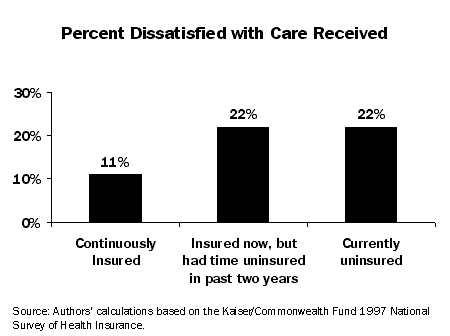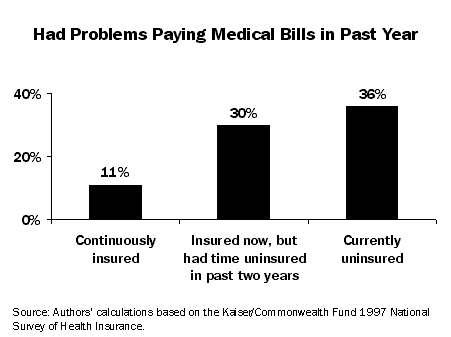For many Americans, health insurance coverage is not a constant. Individuals and families often gain, lose, and then regain health coverage over time as they undergo change in their lives, such as a change in jobs or loss of employment. As a result, the number of those who are insured but have experienced a period without coverage during the year is considerably greater at any given point than the number of uninsured.
For their study “Uninsured and Unstably Insured: The Importance of Continuous Insurance Coverage” (Health Services Research, April 2000, Part II), Cathy Schoen of The Commonwealth Fund and Catherine DesRoches of the Harvard School of Public Health analyzed three different survey databases to examine continuity of health coverage within the U.S. population. The authors find that compared with those who have been continuously insured, insured adults (ages 18 to 64) who have had a recent time without coverage are at high risk for going without needed care and having difficulty paying medical bills. This group is up to three times as likely as the continuously insured to report problems obtaining access to health care services. In fact, rates of access and affordability problems are virtually the same for the recently uninsured as they are for the currently uninsured.
The three surveys used in the study were the Robert Wood Johnson Foundation 1996–1997 Community Tracking Survey, the Kaiser/Commonwealth Fund 1997 National Survey of Health Insurance, and the 1995–1997 Kaiser/Commonwealth State Low-Income Survey.

The findings overall point to the importance of having continuous health insurance coverage and suggest a need to broaden the definition of the uninsured to include individuals currently insured but with a recent time uninsured. All three surveys show a pattern of greater access problems, less connection with regular sources of care, and problems with medical bills among the recently uninsured, indicating that even part-year lapses in coverage can undermine access to care.

On most measures of access, these two groups-adults currently uninsured or recently uninsured-exhibited significant "access gaps" that persist after controlling for other demographic characteristics. Based on reports of satisfaction with care and ratings of physician care, being uninsured for a time also appears to translate into lower-quality care.

Low-income families are most affected by instability in health coverage. Whether because of the lack of employer-based coverage, irregular employment histories, or the unstable nature of Medicaid coverage, low-income adults are the least likely to have continuous coverage and the most likely to have been uninsured. Families led by low-income adults with unstable coverage are at high risk because they are less able to pay directly for needed care or to cope with medical bills if care cannot be delayed. Unless families can plan needed medical care in advance or have the financial resources to pay for care received during spells without health coverage, even a brief time uninsured could disrupt care, cause people to forgo or postpone care, or present an overwhelming financial burden.

Studies that focus on current insurance status alone will necessarily underestimate the extent to which having a time uninsured during the year exacerbates access difficulties and undermines quality of care, the authors conclude. They contend that reforms are needed to ensure continuous insurance coverage, since currently uninsured and unstably insured adults are both at high risk. Maintaining insurance coverage and avoiding spells uninsured, they say, should become a key concern of policymakers in shaping initiatives that extend coverage to the uninsured.
Facts and Figures
- About 52 million Americans had a time uninsured in 1995, nearly 30 percent higher than the 40 million uninsured estimated for 1995 based on the Current Population Survey.
- According to the Robert Wood Johnson survey, recently uninsured adults are twice as likely to have incomes under $30,000 as adults with continuous insurance (60% vs. 29%).
- Among low-income adults ages 18 to 64, those who have had a time without health coverage in the past two years are nearly three times as likely as those with continuous coverage to have not gotten needed care in the previous year.
- According to the Kaiser/Commonwealth National Survey, the recently uninsured were twice as likely as the continuously insured (22% vs. 11%) to be dissatisfied with care received in the past year.